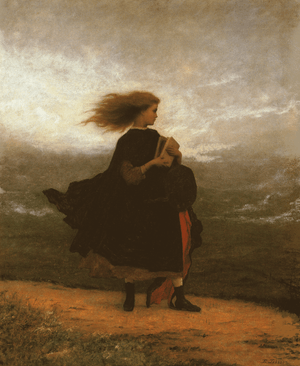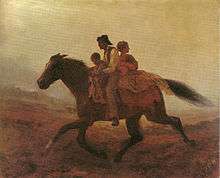The Girl I Left Behind Me (painting)
 | |
| Artist | Eastman Johnson |
|---|---|
| Year | 1875 |
| Medium | oil on canvas |
| Dimensions | 106.7 cm × 88.7 cm (42.0 in × 34.9 in) |
| Location | Smithsonian American Art Museum, Washington, D.C. |
The Girl I left behind me is an oil painting by Eastman Johnson, from 1875.
The subject on a hill in the wind girl is waiting. According to Elizabeth Broun, director of the Smithsonian American Art Museum in Washington, DC, it is one of the most expressive portraits of the 19th century American art.[1]
Description
The painting has dimensions 106.7 × 88.7 centimeters. In the center of the picture is a young woman shown in profile, in a stormy landscape, looking out. She wears a dark jacket, waving in the wind with red coat lining that reaches above the knees, and high black shoes. With the set in the chest hands she holds two books and a dark brown hat hanging in front of her torso. On the left hand, the young girl wears a ring, probably a wedding ring. Her reddish-brown hair blown by the wind.
The background is a hilly area, in this scene is located. The upper third is thereby occupied by gray-white sky, which merges into the gray level on the horizon. Except for a fence there no details can be seen. The girl herself standing on a raised sand yellow path that merges in the front right corner to sparse ruderal plants.
The signature of the artist E Johnson is located in the lower right corner on the way, which is cut off here.
Analysis
The painting was created in 1875 and is named after a same Irish folk song with the following text:
- I seek for one as fair and gay,
- But find none to remind me
- How blest the hours pass'd away
- With the girl I left behind me.[2]
This song, which was published in 1810 in Dublin from a 1759 poem, was a popular ballad of the American Civil War, for the military personnel of the Northern states (Yankees), which was sung in several different versions and with different verses. Eastman Johnson was not involved as a soldier in the war, however, he accompanied the Union forces under General McClellan and 1862 witnessed the Second Battle of Bull Run.

In several subsequent works he dealt with this experience, especially in the image A Ride for Liberty – The Fugitive Slaves of 1862, on which a black family is shown on the escape to freedom. In the picture The Girl I left behind me the link, however, is only visible through the titles conferred by him, Elizabeth Broun, however, brings up the question, if the sky depicted in the background could not be obscured by the smoke and fumes of guns.[3]
Provenance
Eastman Johnson did not sell the painting during his lifetime; it was found with him on his death on April 5, 1906. In 1875 and 1876, however, he showed it, in several exhibitions in Chicago, Brooklyn and Philadelphia. After the death of Johnson, it went into the possession of his heirs and was sold after the death of Ralph Cross Johnson in 1907 by his wife Alexander Hamilton Rice, to the Smithsonian American Art Museum.[4]
Notes
- ↑ Director's Choice am Smithsonian American Art Museum
- ↑ Gaethgens 1988.
- ↑ Director's Choice am Smithsonian American Art Museum, Seite 2
- ↑ Smithsonian year: annual report of the Smithsonian Institution. Smithsonian Institution Press. 1988.
References
- Gaethgens, Thomas W. (1988). Bilder aus der Neuen Welt. Amerikanische Malerei des 18. und 19. Jahrhunderts. Prestel-Verlag. pp. 57–58. ISBN 3-7913-0879-3.
- De Lafayette, Maximillien (2010). History how Pilgrims, and Afro-american Slaves Brought Music to America. Lulu Com. p. 56. ISBN 978-0-557-84323-7.
- Prelinger, Elizabeth (June 2000). The Gilded Age: treasures from the Smithsonian American Art Museum. Watson-Guptill Publications.
- This article incorporates information from the equivalent article on the German Wikipedia.